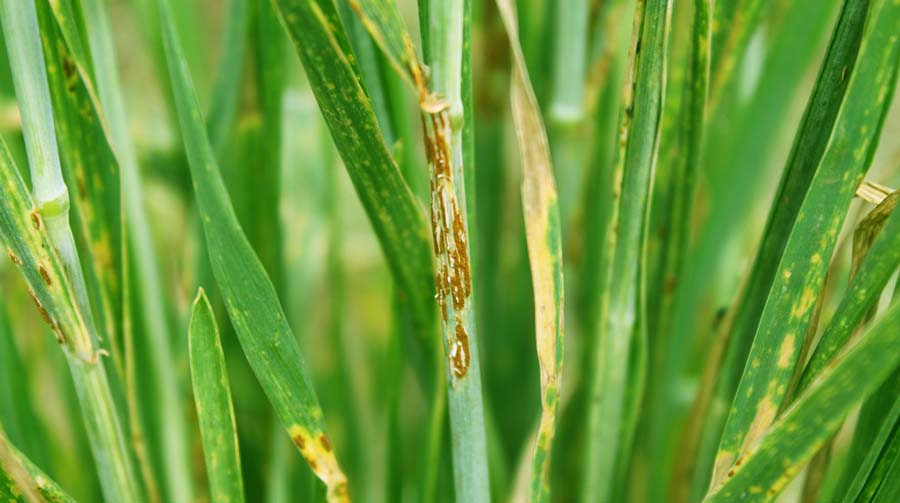30/01/18
Wheat plague spreading through Yemen

By: Adel Aldaghbashy
Send to a friend
The details you provide on this page will not be used to send unsolicited email, and will not be sold to a 3rd party. See privacy policy.
[SANA'A] Agricultural experts are seriously concerned about the spread of stem rust through Yemen to the world’s major wheat production regions, where it could wipe out huge cultivation areas of a crop crucial for food security.
Stem or black rust is a disease that hits basic agricultural crops such as wheat and barley. It is caused by a Puccinia fungus which attacks a plant’s stem, roots and leaves, but mostly damages the stem.
"As a gateway to Asia [from the south-west], Yemen has become one of the important areas of research, study, and intensified efforts related to the spread of the disease," said Salah Hajj Hassan, who represents the UN Food and Agriculture Organization (FAO) in Yemen.
Wheat is a source of food and livelihood for more than one billion people in developing countries. The FAO estimates that 31 countries in North and East Africa, as well as across Asia, account for 37 per cent of the world’s wheat production.
If the conditions are right, black rust disease is capable of causing losses [of] up to 100 per cent of the crop within weeks
David Hodson
According to two studies published early last year by a group of scientists in collaboration with the FAO, new strains of yellow and black rust appeared in several parts of the world in 2016. These added to older strains that have been spreading in Europe, Africa, and Asia.
Another study, published in the journal Nature Plants in the last quarter of 2017, focused on identifying and tracking the fungi responsible for the spread of wheat rust across continents. It was this research which eventually confirmed that "Yemen is an important spore donor country and ‘stepping stone’ for transmission”.
"Yemen is a ‘green bridge’ for these diseases to [spread to] major wheat-cultivation countries," Wageeh Al-Mutawakil, an expert at the General Authority for Agricultural Research and Extension in Yemen, told SciDev.Net.
Abdullah Sailan, a coordinator of wheat research at the Authority, explained that wheat rust diseases usually spread from Uganda to Kenya, Ethiopia and then Yemen, before moving on to Asian countries, Australia, and North America."Monsoons are the main cause of the spread of [the] fungus from Africa to Yemen,” Sailan explained. “As soon as any new strain emerges in Ethiopia, it appears directly in Yemen because of the wind movement."
Wind movement helps the disease spread rapidly across large areas. If not detected and treated effectively, it could destroy healthy crops weeks before harvest — reducing them to fragile yellow leaves, black stems, and scrawny grains.
"If the conditions are right, black rust disease is capable of causing losses [of] up to 100 per cent of the crop within weeks," said David Hodson, a senior scientist with the International Maize and Wheat Improvement Center (CIMMYT).
Al-Mutawakel pointed out that since an outbreak of the fungus first appeared in Yemen in 2006, huge resources have been allocated and several projects implemented to confront the problem.
According to Sailan, internationally imported sensors planted in Yemen’s Jahran district, in the central province of Dhamar, managed to detect the ferocious strain of the fungus that appeared in 2016, which was named Ug99 when it was discovered in Uganda in 1999. He says it can infect wheat cultivars that are able to resist other strains.
The spread of the disease over an extended period, and the emergence of new strain variants of the fungus, have further weakened the resistance of wheat plants — and this indicates that the threat posed by the disease is escalating, according to Sailan.
FAO is working with partners to tackle the outbreak, intensifying the training of specialists in affected countries, especially Yemen, in order to enhance their ability to detect and deal with rust strains.
"Currently, under the conditions in Yemen, the level of communication has dropped to some extent, restricting access to materials required to follow the development of the disease," said Sailan.
However, Yemen’s agricultural research authority continues its efforts to cultivate wheat that can resist black, yellow and brown rust — these have been studied in previous years, and have limited spread of the disease to a great extent, according to Sailan. To prevent severe infections in the future, the authority recommends spraying the crop with fungicides.
Although the threat remains imminent, Yemen's farmers are preparing to expand wheat cultivation this season, particularly in the governorates of Sa’ada, Al Mahwit, Amran, and Al Jawf. Under the ongoing conflict conditions that weaken monitoring capacity, this suggests a growing risk of disease that is likely to go undetected.
According to Hassan, “the solution lies in the exchange of information and materials, as well as the continuous coordination between organizations and concerned parties, to overcome the danger before it escalates”.
This piece was produced by SciDev.Net’s Middle East & North Africa desk.













